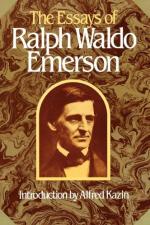5. Shakspeare, in common with his comrades, esteemed the mass of old plays, waste stock, in which any experiment could be freely tried. Had the prestige[541] which hedges about a modern tragedy existed, nothing could have been done. The rude warm blood of the living England circulated in the play, as in street-ballads, and gave body which he wanted to his airy and majestic fancy. The poet needs a ground in popular tradition on which he may work, and which, again, may restrain his art within the due temperance. It holds him to the people, supplies a foundation for his edifice; and, in furnishing so much work done to his hand, leaves him at leisure, and in full strength for the audacities of his imagination. In short, the poet owes to his legend what sculpture owed to the temple. Sculpture in Egypt, and in Greece, grew up in subordination to architecture. It was the ornament of the temple wall: at first, a rude relief carved on pediments, then the relief became bolder, and a head or arm was projected from the wall, the groups being still arranged with reference to the building, which serves also as a frame to hold the figures; and when, at last, the greatest freedom of style and treatment was reached, the prevailing genius of architecture still enforced a certain calmness and continence in the statue. As soon as the statue was begun for itself, and with no reference to the temple or palace, the art began to decline: freak, extravagance, and exhibition, took the place of the old temperance. This balance-wheel, which the sculptor found in architecture, the perilous irritability of poetic talent found in the accumulated dramatic materials to which the people were already wonted, and which had a certain excellence which no single genius,[542] however extraordinary, could hope to create.
6. In point of fact, it appears that Shakspeare did owe debts in all directions, and was able to use whatever he found; and the amount of indebtedness may be inferred from Malone’s[543] laborious computations in regard to the First, Second, and Third parts of Henry VI., in which, “out of 6043 lines, 1771 were written by some author preceding Shakspeare; 2373 by him, on the foundation laid by his predecessors; and 1899 were entirely his own.” And the proceeding investigation hardly leaves a single drama of his absolute invention. Malone’s sentence is an important piece of external history. In Henry VIII, I think I see plainly the cropping out of the original rock on which his own finer stratum was laid. The first play was written by a superior, thoughtful man, with a vicious ear. I can mark his lines, and know well their cadence. See Wolsey’s soliloquy,[544] and the following scene from Cromwell,[545] where,—instead of the meter of Shakspeare, whose secret is, that the thought constructs the tune, so that reading for the sense will best bring out the rhythm,—here the lines are constructed on a given tune, and the verse has even a trace of pulpit eloquence. But the play contains, through all its length, unmistakable traits of Shakspeare’s hand, and some passages, as the account of the coronation,[546] are like autographs. What is odd, the compliment to Queen Elizabeth[547] is in bad rhythm.[548]




